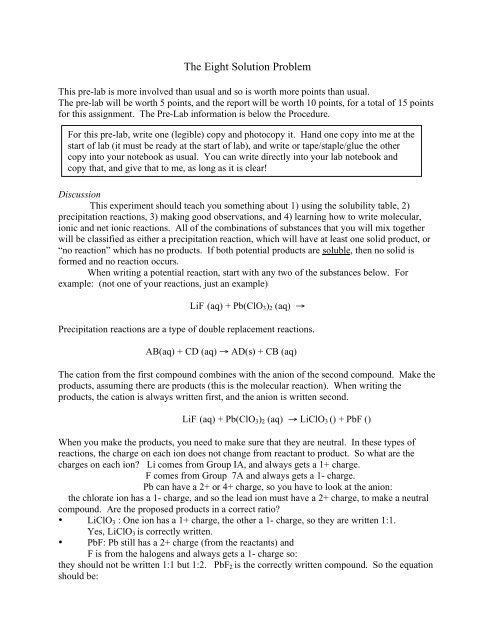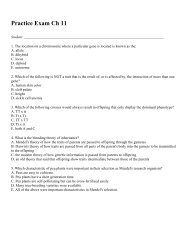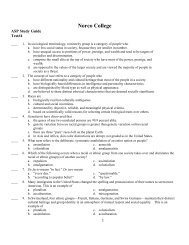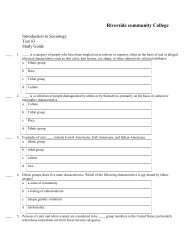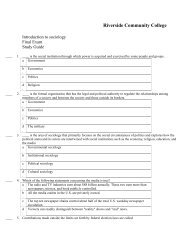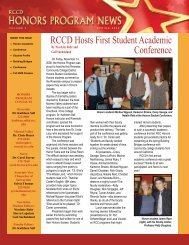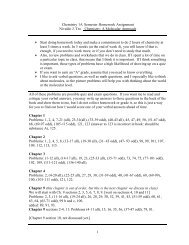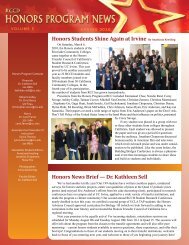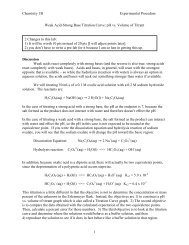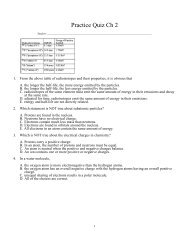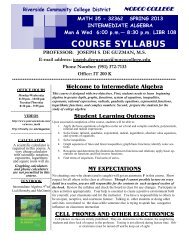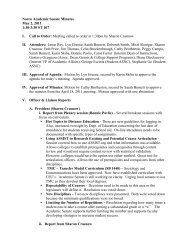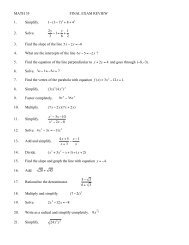The Eight Solution Problem
The Eight Solution Problem
The Eight Solution Problem
Create successful ePaper yourself
Turn your PDF publications into a flip-book with our unique Google optimized e-Paper software.
<strong>The</strong> <strong>Eight</strong> <strong>Solution</strong> <strong>Problem</strong><br />
This pre-lab is more involved than usual and so is worth more points than usual.<br />
<strong>The</strong> pre-lab will be worth 5 points, and the report will be worth 10 points, for a total of 15 points<br />
for this assignment. <strong>The</strong> Pre-Lab information is below the Procedure.<br />
For this pre-lab, write one (legible) copy and photocopy it. Hand one copy into me at the<br />
start of lab (it must be ready at the start of lab), and write or tape/staple/glue the other<br />
copy into your notebook as usual. You can write directly into your lab notebook and<br />
copy that, and give that to me, as long as it is clear!<br />
Discussion<br />
This experiment should teach you something about 1) using the solubility table, 2)<br />
precipitation reactions, 3) making good observations, and 4) learning how to write molecular,<br />
ionic and net ionic reactions. All of the combinations of substances that you will mix together<br />
will be classified as either a precipitation reaction, which will have at least one solid product, or<br />
“no reaction” which has no products. If both potential products are soluble, then no solid is<br />
formed and no reaction occurs.<br />
When writing a potential reaction, start with any two of the substances below. For<br />
example: (not one of your reactions, just an example)<br />
LiF (aq) + Pb(ClO 3 ) 2 (aq) <br />
Precipitation reactions are a type of double replacement reactions.<br />
AB(aq) + CD (aq) AD(s) + CB (aq)<br />
<strong>The</strong> cation from the first compound combines with the anion of the second compound. Make the<br />
products, assuming there are products (this is the molecular reaction). When writing the<br />
products, the cation is always written first, and the anion is written second.<br />
LiF (aq) + Pb(ClO 3 ) 2 (aq) LiClO 3 () + PbF ()<br />
When you make the products, you need to make sure that they are neutral. In these types of<br />
reactions, the charge on each ion does not change from reactant to product. So what are the<br />
charges on each ion? Li comes from Group IA, and always gets a 1+ charge.<br />
F comes from Group 7A and always gets a 1- charge.<br />
Pb can have a 2+ or 4+ charge, so you have to look at the anion:<br />
the chlorate ion has a 1- charge, and so the lead ion must have a 2+ charge, to make a neutral<br />
compound. Are the proposed products in a correct ratio?<br />
• LiClO 3 : One ion has a 1+ charge, the other a 1- charge, so they are written 1:1.<br />
Yes, LiClO 3 is correctly written.<br />
• PbF: Pb still has a 2+ charge (from the reactants) and<br />
F is from the halogens and always gets a 1- charge so:<br />
they should not be written 1:1 but 1:2. PbF 2 is the correctly written compound. So the equation<br />
should be:
LiF (aq) + Pb(ClO 3 ) 2 (aq) LiClO 3 () + PbF 2 ()<br />
Now the question of whether or not the reaction will actually occur. Look at the solubility table<br />
(check the index). If one or both of the products is insoluble (becomes a solid), a precipitation<br />
reaction will occur. If neither product is insoluble, no reaction occurs.<br />
To start, look for the ion rather than the compound. According to the table, ionic<br />
compounds containing the chlorate ion are all soluble, and so LiClO 3 is (aq). Looking at the<br />
table again, look for either the Pb 2+ ion or the F - ion. All ionic compounds containing F - are<br />
soluble, except for “fluorides of Mg 2+ , Ca 2+ , Sr 2+ , Ba 2+ , and Pb 2+ ”. This means that PbF 2 is<br />
insoluble and a reaction should occur. Write the reaction with the states and balance it. <strong>The</strong><br />
order of the products does not matter.<br />
2 LiF (aq) + Pb(ClO 3 ) 2 (aq) 2 LiClO 3 (aq) + PbF 2 (s)<br />
If both products are soluble, then they are not made; and so you should put the products<br />
in brackets and write “N.R.” for “no reaction”.<br />
For example: LiI (aq) + Mg(CH 3 CO 2 ) 2 (aq) <br />
Find the charge on each ion:<br />
Li 1+ (see above)<br />
F - (a halogen, so 1- charge)<br />
Mg (in alkaline earth metals) so Mg 2+<br />
-<br />
CH 3 CO 2 : this is the polyatomic ion acetate, and the charge on it may be<br />
memorized, or you can figure it out because Mg has a 2+ charge and there are two acetate ions,<br />
so the charge on each ion must be 1-.<br />
Compounds containing I - are soluble with the exceptions of silver ion, mercury ion and lead ion.<br />
Since I is combined with Li, the compound is soluble. It also states in the table that all ionic<br />
compounds containing acetate ions are soluble; therefore you should conclude that there is no<br />
reaction. <strong>The</strong> equation can be written this way:<br />
LiI (aq) + Mg(CH 3 CO 2 ) 2 (aq) [LiCH 3 CO 2 (aq) + MgI 2 (aq) ] N.R.<br />
You can also put an “X” over the arrow. I just haven’t figured out how to do that on my<br />
computer.<br />
Procedure<br />
For this experiment, there will be eight solutions already made. All of the substances<br />
below have been dissolved in water, and are therefore aqueous solutions. <strong>The</strong>se solutions, in no<br />
particular order, are:<br />
3 M NaOH 0.05 M Na 2 S 0.2 M BaCl 2<br />
1 M NH 4 Cl 0.03 M Na 2 SO 4 0.01 M AgNO 3<br />
0.1 M KI Distilled H 2 O
First, you will mix all combinations of two solutions, and write down what you observe,<br />
in each case.<br />
For instance, starting with 3 M NaOH mix 10 – 20 drops of NaOH with 10-20 drops of<br />
NH 4 Cl and write down any color changes, precipitates formed, odors that go away, or are new.<br />
<strong>The</strong>n mix NaOH with KI and record what you see, and so forth. Once you have completed all<br />
combinations of two solutions containing NaOH, then start with NH 4 Cl and continue the process.<br />
(Since you have already combined NaOH and NH 4 Cl in the previous series, you do not have to<br />
repeat this experiment.) In all mixtures, use equal numbers of drops of the two substances, and<br />
be consistent in your methodology.<br />
Once you have completed all of the reactions described above, you will have available<br />
another set of the same solutions, and this set of solutions will be labeled A, B, C, D, E, F, G and<br />
H. <strong>Solution</strong> A does not necessarily correlate with NaOH. Your job will be to use the<br />
information that you learned from the first series of experiments to identify which solution is<br />
contained in each lettered bottle. For this part, you may use only the unknown solutions to figure<br />
out the correct substance in each bottle. Also, these are individual experiments. You should not<br />
be consulting with each other about one another’s results. This is a quiet lab.<br />
Pre-Lab<br />
Your pre-lab consists of this: first write the reactants for each of the potential reactions.<br />
For instance, the first two sets of reactants could be:<br />
NaOH (aq) + NH 4 Cl(aq) <br />
NaOH (aq) + KI (aq) <br />
Write these out for each possible combination. Next, use the solubility table, and figure<br />
out which reactions should occur, and write out what the products should be and the states of<br />
each product. If no solid is expected to form, then a reaction is not occurring. If no reaction is<br />
expected to occur, put the would-be products in brackets and write “N.R.” for “no reaction” after<br />
the arrow.<br />
Remember that each one of these solutions contains an ionic compound, except for the<br />
distilled water which is not a solution but a pure liquid. In order to correctly write out and<br />
balance the chemical reaction, you must determine the correct charges on each ion and, when<br />
forming a product, make sure that the products are in fact neutral! [ This is very important.]<br />
Report<br />
Observations of each mixture or chemical reaction, (each equation should include an<br />
observation). Write the reactants for all 28 combinations and list the observations of each<br />
substance by itself, and each of the 28 combinations. Include colors, textures and odors (which<br />
sometimes appear and sometimes disappear).<br />
Chemical Reactions – write the molecular, ionic and net ionic equation for only the actual<br />
chemical reactions.
Discussion. Discuss any points that you think require discussion. For example, if you had<br />
trouble figuring out the identity of one or two unknowns, what caused the uncertainty and how<br />
did you resolve it?<br />
Conclusion.<br />
<strong>The</strong> conclusion is the list of letters and their corresponding compounds in solution.<br />
As before, this report can be hand written (legibly) or typed.


